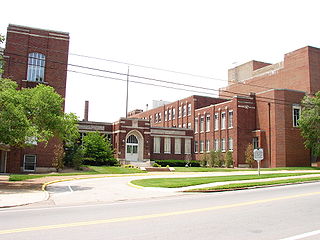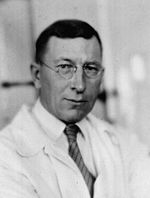
The University of Toronto Faculty of Dentistry is a dental school located in Toronto, Ontario, Canada. It is one of the ten dental schools in Canada. It is the largest dental school in Canada with a range of undergraduate and graduate level programs with a total enrolment in the range of 560. The faculty is located at the heart of Downtown Toronto's Discovery District, a neighbourhood with a high concentration of hospitals and research institutes, just south of the University of Toronto's St. George campus. In 2014, the Faculty of Dentistry joined the Toronto Addis Ababa Academic Collaboration (TAAAC), providing support in building capacity for oral health in Ethiopia by creating collaborative teaching opportunities.

The University of Tennessee Health Science Center (UTHSC) is a public medical school in Memphis, Tennessee. It includes the Colleges of Health Professions, Dentistry, Graduate Health Sciences, Medicine, Nursing, and Pharmacy. Since 1911, the University of Tennessee Health Science Center has educated nearly 57,000 health care professionals. As of 2010, U.S. News & World Report ranked the College of Pharmacy 17th among American pharmacy schools.

The Harvard School of Dental Medicine (HSDM) is the dental school of Harvard University. It is located in the Longwood Medical Area in Boston, Massachusetts. In addition to the DMD degree, HSDM offers specialty training programs, advanced training programs, and a PhD program through the Harvard Graduate School of Arts and Sciences. The program considers dentistry a specialty of medicine. Therefore, all students at HSDM experience dual citizenship between Harvard School of Dental Medicine and Harvard Medical School. Today, HSDM is the smallest school at Harvard University with a total student body of 280.
A number of professional degrees in dentistry are offered by dental schools in various countries around the world.

The UCLA School of Dentistry is the dental school of the University of California, Los Angeles (UCLA) located in the Center for Health Sciences building in the Westwood neighborhood of Los Angeles, California, United States. The school has several educational and training programs, conducts oral and dental health research, and offers affordable dental care at three locations: Westwood, Venice, and Inglewood. The school also participates in several outreach endeavors, including numerous health fairs during the year, STEM pipeline programs and provides dental care for underserved populations in the region. The School of Dentistry is considered among the nation's best research-intensive dental schools.
Tufts University School of Dental Medicine (TUSDM) is a private, American dental school located in the Chinatown neighborhood of Boston, Massachusetts, and is connected to Tufts Medical Center. It is one of the 8 graduate schools that comprise Tufts University. Founded in 1868 as Boston Dental College by Dr. Isaac J. Wetherbee, the university is the second oldest dental school in the city, and one of the oldest in the country.
The University of Pittsburgh School of Dental Medicine is the dental school of the University of Pittsburgh (Pitt). It is located in Pittsburgh, Pennsylvania, United States. It is one of Pitt's six schools of the health sciences and one of several dental schools in Pennsylvania. It is closely affiliated with the University of Pittsburgh Medical Center. The School of Dental Medicine accepted 3.6% of applicants for the class of 2016, a record low for the school's entire history.

The Faculty of Dental Medicine and Oral Health Sciences is one of the constituent faculties of McGill University. It became established as a constituent of McGill University in 1904 as the McGill Dental School, a department in the McGill University Faculty of Medicine until becoming its own faculty in 1920. In 2022, the Faculty of Dentistry was renamed as the Faculty of Dental Medicine and Oral Health Sciences to reflect the diversity of research conducted in the Faculty that goes beyond the dental chair. The Faculty is closely affiliated with the Montreal General Hospital, Jewish General Hospital, Montreal Children's Hospital, and McGill University Faculty of Medicine.

Dentistry throughout the world is practiced differently, and training in dentistry varies as well.
New Jersey Medical School (NJMS)—also known as Rutgers New Jersey Medical School—is a medical school of Rutgers University, a public research university in Newark, New Jersey. It has been part of the Rutgers Division of Biomedical and Health Sciences since the 2013 dissolution of the University of Medicine and Dentistry of New Jersey. Founded in 1954, NJMS is the oldest school of medicine in New Jersey.
In Canada, a medical school is a faculty or school of a university that trains future medical doctors and usually offers a three- to five-year Doctor of Medicine (M.D.) or Doctor of Medicine and Master of Surgery degree. There are currently 17 medical schools in Canada with an annual admission success rate normally below 7.5%. As of 2021, approximately 11,500 students were enrolled in Canadian medical schools graduating 2,900 students per year.
The Melbourne Dental School is one of the graduate schools of the University of Melbourne. In addition to the 4-year graduate dental program the Doctor of Dental Surgery, the school offers specialty training programs combined with the Doctor of Clinical Dentistry degree, advanced training programs, and research degrees including M.Sc. and Ph.D. programs. According to the QS World Rankings, it is the highest ranking dental school in Australia and often ranks among the top 25 in the world.

The Columbia University College of Dental Medicine, often abbreviated CDM, is one of the twenty graduate and professional schools of Columbia University. It is located at 630 West 168th Street in Manhattan, New York City. According to American Dental Education Association, CDM is one of the most selective dental schools in the United States based on average DAT score, GPA, and acceptance rate. In 2017, 1,657 people applied for 84 positions in its entering class. The median undergraduate GPA and average DAT score for successful applicants in 2020 were 3.62 and 22.8, respectively.

The Ohio State University College of Dentistry is one of the graduate and professional schools of The Ohio State University. The college is the fourth largest public dental school in the U.S. and consists of nine academic divisions representing all major dental specialties. In addition to the Doctor of Dental Surgery (D.D.S.) and Bachelor of Science in Dental Hygiene degrees, the Ohio State College of Dentistry offers specialty training programs, advanced training programs, MS programs, and a Ph.D. program in Oral Biology. Outreach and Engagement activities include over 60 active programs and more than 42 extramural sites, which continue to expand.

The George Washington University School of Medicine and Health Sciences is the professional medical school of the George Washington University, in Washington, D.C. SMHS is one of the most selective medical schools in the United States based on the number of applicants.

The School of Dentistry is a dental school within Meharry Medical College located in the United States city of Nashville, Tennessee.

The UNC Claude A. Adams Jr. and Grace Phillips Adams School of Dentistry is the school of dentistry of the University of North Carolina. It is located in Chapel Hill, North Carolina, United States. It is currently ranked second among all dental schools in the U.S. and is consistently ranked among the best in the world according to two independent rankings. Founded in 1950 as the UNC School of Dentistry, it was the only dental school in North Carolina until 2011, when East Carolina University School of Dental Medicine became the second. In 2019, the school received its largest single donation of $27.68 million, resulting in a name change to honor Dr. Claude A. Adams Jr. and Grace Phillips Adams. Dr. Adams was a North Carolina dentist that practiced in Durham until his death in 2018.

The University of Michigan School of Dentistry is the dental school of the University of Michigan, a public research university located in Ann Arbor, Michigan. Established in 1875, the School of Dentistry engages in oral and craniofacial health care education, research, patient care and community service. It is currently the number one ranked dental school in the U.S. and fifth in the world according to two independent rankings.

The Michael G. DeGroote School of Medicine, known as the McMaster University School of Medicine prior to 2004, is the medical school of McMaster University in Hamilton, Ontario, Canada. It is operated by the McMaster Faculty of Health Sciences. It is one of two medical programs in Canada, along with the University of Calgary, that operates on an accelerated 3-year MD program, instead of the traditional 4-year MD program.
Arlington Franklin Dungy was a Canadian dentist who practiced in Ontario, and was a known advocate for a more inclusive medical community. He specialized in paediatric dentistry, and practiced first in Toronto, before accepting the role of chief of dentistry at Ottawa's Children’s Hospital of Eastern Ontario. His academic career included the positions of dean of alumni and student affairs and associate dean of professional affairs, at the University of Ottawa Faculty of Medicine. During his tenure at the University of Ottawa, he co-founded the Indigenous admissions program, as well as two scholarships, to address a lack of Indigenous representation within the Canadian medical profession. He was fondly known as "Arlie" by people close to him.

















